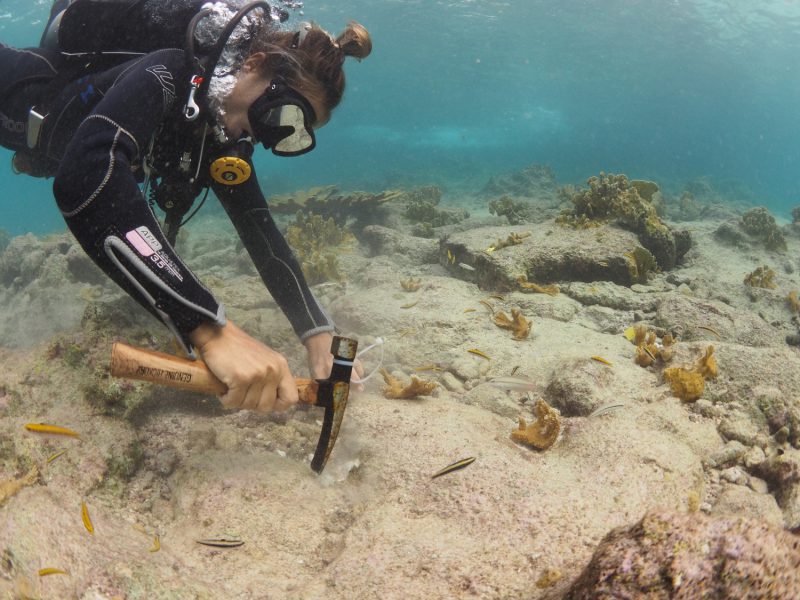Thanks to funding through the BEST 2.0 Programme supported by the European Commission, Reef Renewal Foundation Bonaire (formerly Coral Restoration Foundation Bonaire) is proud to announce the completion of a year-long project at Oil Slick Leap, “Pop-up nursery and coral restoration.”
Last year, in January 2018, Reef Renewal Foundation Bonaire (formerly Coral Restoration Foundation Bonaire) installed a pop-up coral nursery at Oil Slick Leap. The coral nursery consisted of seven trees which were installed at the site temporarily and were removed at the end of the year-long project, leaving no visible trace of what was once there.

After propagation throughout the year, the nursery was full with over 750 Elkhorn corals (Acropora palmata) that were ready to be outplanted onto the reef by October. During that time, the nursery was maintained and surveyed by RRFB staff and volunteers, including several STINAPA Jr. Rangers who are trained in coral restoration.
At the beginning of October, outplanting started. The pop-up nursery provided simplified logistics for the outplanting phase of the project because the nursery was situated just a few meters’ swim from the restoration site. This close proximity also eliminated the stress of transportation of the corals by boat, potentially increasing the survival of the outplanted corals. Throughout the course of about 2 months, 763 Elkhorn corals were outplanted back to the reef at Oil Slick. Corals of different strains were strategically planted to maximize genetic diversity at the site and were attached to the bottom using a marine epoxy.


After outplanting, though, the work isn’t done. To better assess the method and techniques, coral monitoring takes place at specific intervals over time. Before outplanting, an orthomosaic of the entire restoration site is created. This is done by swimming over the entire site while taking photographs and then using a software to stitch them all together, creating a high-resolution image of the area. The orthomosaic is then repeated when all of the corals are outplanted and is used to measure coral cover, expansion, and colony survival at a reef-wide scale, allowing RRFB to monitor how the entire site changes, not only individual corals.
Paired with the site-wide monitoring, is a more fine-scale program to assess coral health on a subset of the outplanted corals. This program includes surveys conducted by divers to collect data on the coral health, mortality, and stressors, such as competition, disease, and predation. Photos taken during the dives were also used to create digital 3D models of the corals, which proved to be a reliable monitoring tool for outplanted Elkhorn corals in order to collect additional important information, (i.e. volume, surface area, etc.) that can be compared over time.
With all of the corals grown in the coral nursery outplanted and the trees removed, the monitoring continues throughout the long-term to evaluate the success of the restoration efforts.
Since the 1980’s, Elkhorn coral populations have declined around the Caribbean, and recent studies in Bonaire show dramatic changes in the reef communities since then. This project was an important step toward restoring Elkhorn corals in Bonaire’s shallow waters by adding both more corals and more genetic diversity to Oil Slick Leap. The strategic outplanting of these different genotypes at the same site will ideally give the reef a helping hand by providing better chances for successful reproduction and fertilization at annual spawning events. By assisting the natural recovery of these corals and developing innovative nursery and monitoring techniques, this project has made important strides toward restoring Elkhorn corals in Bonaire and laid the groundwork for more successful reef restoration in the years to come.
This project, which was funded by the BEST 2.0 Programme of the European Commission, has been documented with a video (available here) that shows the different phases of the projects, people involved, goals and accomplishments.
A special thanks to the STINAPA Jr. Rangers for volunteering during the course of the project by performing nursery maintenance, conducting surveys, and assisting with outplant monitoring, and to the Bonaire National Marine Park for approving and supporting the project.
To learn more about the European Union’s BEST 2.0 Programme, visit: https://portals.iucn.org/best/.
This document has been produced with the financial assistance of the European Union. The contents of this document are the sole responsibility of Reef Renewal Foundation Bonaire and can under no circumstances be regarded as reflecting the position of the European Union.




